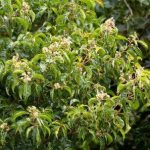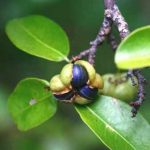TREE LIFE
MARCH 1994
MASHONALAND CALENDAR
Tuesday 1st March. Botanic Garden Walk. Park at the Herbarium at 4.45 for 5 p.m. where we will meet Mr. Tom Muller.
Sunday 20th March. It has been many years since we visited Ivordale Farm in the Enterprise area, and happily the owners Mr. and Mrs. Pascoe, have agreed to a return visit. During our recce we found an ideal spot – a shallow dwala near the access road that contains an interesting hotchpotch of species.
The distance from Harare is about 50 km so allow an hour travelling time to meet at 9.30 a.m.
Saturday 26th March. Botanic Interest Walk. Phone Mark for venue and time.
Easter 1-4th April. Unfortunately it has not been possible to arrange a trip to West Nicholson for Easter, see April 15-18th for a possible alternative.
MATABELELAND CALENDAR
Sunday 6th March. An all day visit to Greenland Farm and the Brownlee-Walkers about 70 km north of Bulawayo on the Harare Road. Bring tea, lunch, chairs etc. for an 8.30 a.m. departure from Girls’ College.
Easter Monday 4th April. An all day visit to Sotshe and Mtshabezi.
Easter Weekend. We regret that the visit to West Nicholson has not come off but we hope to combine with Harare later in April. So please check the Harare calendar for April’s extended visit.
Thursday 7th April. The A.G.M. and video evening at Girls College. Meet at 7.15 p.m. for 7.30 p.m. – tea and coffee will be served.
A NOTE ON SUBSCRIPTIONS. These will be due very soon. If you are a Bulawayo member please make your payment directly to the National Treasurer and not to the local committee.
On February 1st, in lieu of our usual Botanic Garden Walk there was a small gathering in front of the Herbarium when we, together with the staff members of the Herbarium formally said ‘Thank You’ to Mr. Bob Drummond. The response from members, to the invitation to donate towards a presentation gift was overwhelming, and donations were received from all parts of the country. Mr. and Mrs. Drummond chose a very nice Mukwa filing cabinet. Mr. Tom Muller made the presentation after a short speech.
It was especially good to have several out-of-towners in our midst. Thank you for making the occasion a success by your presence, your contributions towards the gift and for the amazing variety of really delicious eats for tea.
Our presentation to Tom, which will take place a little later this year, will be advertised in Tree Life.
IVORY LODGE Tree Society visit to Ivory Safaris Wankie National Park 4 – 6 February 1994
4th February 1994 After arriving at Ivory Safaris at about 12 o’clock on Friday we could see already that there were going to be plenty of plants of interest to look at. Having settled our luggage in our allocated tree lodges we made our way to the bar for refreshments before sitting down to a very satisfying lunch. After lunch most if not all of us, strolled through and around the camp to feast our eyes on the array of trees and shrubs occurring there. The soil in and around the camp was a mixture of Kalahari sand and ferricrete with a certain amount of clay, which was the reason for the diversity of species that we found. (49 in all, although I suspect that we would have found a few more if we had spent more time in the vicinity of the camp.
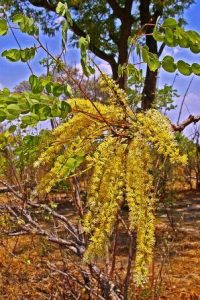
Amblygonocarpus andongensis. Photo: Meg Coates Palgrave. Source: Flora of Zimbabwe
The species positively identified were: Acacia ataxacantha, Acacia erioloba, Acacia fleckii, Amblygonocarpus andongensis, Azanza garckeana, Baphia massaiensis, Bauhinia petersiana, Boscia angustifolia, Brachystegia boehmii, Brachystegia spiciformis, Bridelia cathartica, Burkea africana, Catunaregam spinosa, Combretum adenogonium, Combretum apiculatum, Combretum collinum, Combretum hereroense, Combretum zeyheri, Commiphora glandulosa, Commiphora mossambicensis, Commiphora pyracanthoides, Dalbergia melanoxylon, Dichrostachys cinerea, Diospyros mespiliformis, Diplorhynchus condylocarpon, Erythroxylum zambesiacum, Euclea divinorum. Flacourtia indica, Flueggea virosa, Friesodielsia obovata, Hoslundia opposita, Julbernardia globiflora, Lantana sp., Lonchocarpus capassa, Lonchocarpus nelsii (confirmed on Sat.), Markhamia obtusifolia, Pavetta schumanniana, Piliostigma thonningii, Pseudolachnostylis maprouneifolia, Psydrax livida, Pterocarpus angolensis, Pterocarpus rotundifolius, Rhus tenuinervis, Sclerocarya birrea, Securidaca longipedunculata, Terminalia brachystemma, Tinnea rhodesiana, Vangueria infausta, Ziziphus mucronata, Ziziphus abyssinica (confirmed on Sat.).
At about 3 p.m. we set off for the Main Camp road, where we stopped to look at some mature specimens of Amblygonocarpus andongensis (Scotsman’s Rattle), Baikiaea plurijuga (Zambezi Teak), Erythrophleum africanum (Ordeal Tree), and Guibourtia coleosperma (umtshibi or large false mopane), all mainline Kalahari sand species. We then travelled down the track to Ganda Safari Camp with the intention of coming out of the Sikumi Forest near Dete, but we had to turn back due to an area of very slippery clay patches. We had intended to reach an area of Jesse that Jonathan had lined up for us to look at but that will have to wait until a later date.
We were able to see the following plants of interest: –
Acacia nigrescens, Acacia nilotica, Amblygonocarpus andongensis, Baphia massaiensis, Baikiaea plurijuga, Brachystegia spiciformis, Cassia abbreviata, Colophospermum mopane, Combretum adenogonium, Combretum imberbe, Combretum mossambicense, Combretum padoides. Commiphora africana, Commiphora mossambicensis, Croton gratissimus, Croton pseudopulchellus, Dialium englerianum, Dichrostachys cinerea, Erythrophleum africanum, Erythroxylum zambesiacum, Euphorbia matabelensis. Flacourtia indica, Flueggea virosa, Grewia flavescens, Grewia monticola, Guibourtia coleosperma, Kirkia acuminata, Ochna pulchra, Ochna schweinfurthiana. Parinari curatellifolia, Pseudolachnostylis maprouneifolia, Pterocarpus angolensis, Schinziophyton rautanenii, Steganotaenia araliacea, Strychnos cocculoides, Strychnos pungens, Swartzia madagascariensis. Terminalia brachystemma, Terminalia sericea, Tinnea rhodesiana,Ximeniacaffra,Ziziphusmucronata.
It was very encouraging to see the interest of the staff of Ivory Safaris in the flora of the area.
-Anton Ellert
SIKUMI 4th – 6th February 1994 While many of the group went off on an early morning game viewing run, a smaller intrepid party continued with the botanising. This time along the Gwayi River – Kennedy siding road into the southern part of Sikumi Forest. The drive was very varied in terms of vegetation type, with an interesting transition from mopane woodland and Acacia on the clay-rich and seasonally flooded soils close to Gwayi River. Through dry miombo and Kirkia acuminata woodland on the higher ground of Good luck Ranch, to the Kalahari sand woodlands of Sikumi and a good example of a Kalahari sand vlei.
Much time was spent filling in the checklist near Gwayi River, with many unusual species being encountered, often quite heavily browsed. Magnificent tall mopane trees were clumped on old termitaria and smaller shrubs were clustered around them (species?).
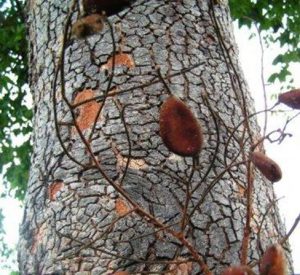
Dialium englerianum. Photo: Jos Stevens. Source: Flora of Zimbabwe
In Sikumi we moved along the old game fence through tall woodland of Brachystegia spiciformis, Combretum collinum and Burkea africana, encountering some nice specimens of the northern Dialium englerianum with its characteristic robust trunk and some large Pterocarpus angolensis, but saw surprisingly little Baikiaea plurijuga, and then only localized. Presumably this was due to the relatively shallow or poorly trained sands in this area. Jijima vlei provided a magnificent panorama of grass¬land stretching before us, but with no game visible. Signs of last year’s burning were still evident, and we cane across a still-smouldering fire deep in the peat of the vlei bed.
After a large lunch, and a brief rest, some of us set off to what should have been a very interesting patch of semi-jesse woodland thicket, containing such species as Kirkia acuminata, Pteleopsis anisoptera, Commiphora karibensis and Strychnos potatorum. But a squall and heavy local rainstorm, probably associated with the cyclone over Madagascar some days previously, washed us, and any residual enthusiasm, out. The call of a hot shower and dry clothes proved too much.
-Jonathon Timberlake
SUNDAY 6TH FEBRUARY
Our first visit to the Gwayi River Terraces was a couple of years back when Kathy Rodgers introduced us to the marvellous botanical diversity of the place. A variety of habitats converge in an area of little more than two square kilometres to provide a rich mosaic of riverine, Kalahari Sand, Jesse, Zambezi Valley and miombo subjects.
On Sunday morning our modus operandi was to follow a catena from the river through the terraces, stopping at strategic points in the different habitats with the purpose of looking at species that were especially unfamiliar to Bulawayo eyes.
There were many familiar faces in the Riverine fringe – Acacia galpinii, Croton megalobotrys, Faidherbia albida, Maytenus heterophylla, etc. but new introductions were Acacia robusta subsp. clavigera, Feretia aeruginescens and Diospyros senensis.
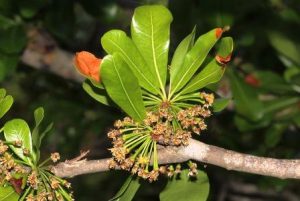
Manilkara mochisia. Photo: Bart Wursten. Source: Flora of Zimbabwe
Beyond the riverine zone stands a belt of majestic cathedral mopane with a very rich diversity of shrubs and smaller trees in the under storey. Here we found Diospyros quiloensis, short, very erect with a crocodile bark, multi-stemmed Pterocarpus lucens, thorny Canthium frangula, Bauhinia tomentosa some still showing their yellow flowers, Albizia anthelmintica and Manilkara mochisia.
In the Miombo woodland besides the usual Brachystegia we saw Lonchocarpus nelsii, Acacia eriocarpa and Vangueriopsis lanciflora. After a second visit, and more than seventy subjects marked on the card I came away from the area feeling there was still much more I needed to assimilate, especially amongst the numerous and baffling Grewia and Combretum. One will simply have to return.
As a footnote to the visit I would like to add our very grateful thanks to John Burton and Ivory Safaris for making it such a pleasurable event. It was all that we could have wished for and even more. Our thanks also go to the Forestry Commission and Mr. Buck de Vries for allowing us onto their land and last but not least to Anton Ellert and Jonathan Timberlake for sharing their expertise and knowledge with us.
-Ian McCausland
Buttressing
In the note on buttressing in TREE LIFE No. 168 it was stated “buttresses are absent in the eucalypts of Australia”. This is not correct. While it is generally true that buttressing in eucalypts is not as spectacular as it is in some rainforest trees, I have observed and photographed very prominent buttresses in Eucalyptus regnans in Victoria, and fairly prominent buttresses in Eucalyptus microcorys in New South Wales. A check through several textbooks reveals some degree of buttressing in practically all of the larger forest eucalypts, and even among some of the woodland species.
In his book Growth Habits of the Eucalypts, M.H. Jacobs wrote; Trees have developed means of adding to the strength of their basal support. The effect of wind sway stimulates the development of the lower part of the trunk and the roots close to it, thus adding to the weight and the strength of the pedestal. There is also a tendency for the tree to put on extra wood near the junction of the main roots with the trunk, as a reaction to the close association between the upward movement of water and the deposition of new wood. This tendency leads to swelling at the junction of the main root with the trunk. The spectacular buttressed roots of tropical rain forests are an extreme example of this.
The following is an extract from The Tropics by Edgar Aubert de la Rue, Francois Bourliere, and Jean-Paul Harroy: The unusual appearance near the foot of a great many trees comes as a surprise to any one walking for the first time under the shade of a tropical rain forest. None of them is more than shallowly rooted and, far from being hidden, their great roots often creep over the surface of the ground. Many of them, belonging to such very different families as, the Leguminosae, Bombacaceae, Sapotaceae, Meliaceae and others, have the foot reinforced with powerful flying buttresses. These often start several yards above the ground and are prolonged to a great distance by high narrow buttress roots which are very sinuous, the whole forming a picturesque pattern of draperies round, the foot of the tree. These buttresses are sometimes so developed that the natives have no trouble in cutting planks out of them, a much easier process than cutting up enormous trunks. This is why these graceful buttresses are so often mutilated and transformed into hideous stumps.
Other trees, both large and small, increase their supporting surface by the aid of a bundle of adventitious roots, some straight and others gracefully arched, that spring from the lower part of the trunk at varying heights; in some species these aerial roots even originate from the branches. The name of “stilt-roots” has been given to this arrangement, which might at first sight be thought to be associated with a marshy habitat. It is indeed in the mangroves (Rhizophora) colonising the salt mud of the shore that these aerial roots attain their highest development. In Australasia and Madagascar many of the Pandanus living in wet places, beside rivers or around lakes, is supported on such roots, which sometimes are several yards in height. But Pandanus is also found on slopes, plateaus and rocky surfaces that are perfectly dry … Stilt roots cannot therefore be regarded as necessarily indicating a humid habitat.
These various arrangements tend to strengthen the forest trees, but their effectiveness is not quite satisfactory, judging by the ease with which so many trees that seem securely buttressed are overthrown by gusts of wind and, much more so, by cyclones in exposed regions.
-L J Mullin.
Ijapo revisited 20 Ferbuary 1994
Many of us had heard about the exciting gorge at Ijapo and on arrival were able to find out a little more about the river and its surrounds a1100 fter a welcome cup of tea.
The lower altitude (metres) produced many and varied species including Xeroderris stuhlmannii also known as the “Wing pod”. And an interesting find of Maerua angolensis with fruit in the form of a series of small spherical balls encased by a thin green pod – hence its common name of “bead bean”. Brian mentioned Diplorhynchus condylocarpon as being very effective birdlime once the white rubbery latex had been boiled. Plain latex, however, has very little strength and consequently has little use. Catunaregam spinosa had sprung up all over the area, mainly as a result of overgrazing in years past, but was now a problem as thickets of extremely spiny plants were developing. For Highveld residents Ijapo’s mix of Combretum was a good revision test with the more distinctive Combretum molle and the shiny leaved Combretum apiculatum. Benedicta’s tip of a “bee sting” at the tip of the leaf was most useful remembering of course that ‘apis’ is the Latin for a bee! Suddenly from a meandering road the gorge appeared below, the river now a quiet gurgle rather than a roaring torrent of a few weeks earlier. The river bed was mostly sand coloured granite scalloped by years of water flowing over it. Every so often an intrusion of black basalt based rock would appear where the upper layers of granite had been eroded. Within rocky confines near the river’s main course interesting pockets of vegetation were noticed but would have to wait for the afternoon’s ramble. The opposite bank, although very rocky was home to a large number of white trunked Albizia tanganyicensis – a wonderful sight against a sea of green woodland. A cluster of strange looking fruits was identified as having come from an Artabotrys brachypetalus, and a vigorous search ensured to find the characteristic “hooks” or peduncles. Olax dissitiflora was much in evidence, seeming to like areas that are hot and dry, and was best explained by the snappy leaf (when broken in two) and the smell of almonds – if patient and lucky!
An almost prehistoric knobbiness of a Zanthoxylum chalybeum may have made a setting for “Jurassic Park by the Umfuli”, but the fiendishly thorny branches kept our minds and fingers in touch as the odd leaflet was plucked for the strong citrus smell typical of the Rutaceae family. The noonday sun and dwindling water supplies drove us back to seek shade at the farmhouse, with a quick diversion to look at the distant range of very broken hills known as the Mcheka-wa-ka-sungabeta Mountains – “the hills that form the Earth’s girdle”. The afternoon ramble on the opposite bank provided us with an Afzelia quanzensis, Sterculia africana and large numbers of Kirkia acuminata whose graceful compound leaves were also feeling the heat. Listening to the crashing about within a rocky crevice it sounded as though Miles Standish-White and others were finding it tough going tiptoeing through the spiny Euphorbia griseola! The environs of the river were also borne to an exciting array of Commiphora, namely, Commiphora mossambicensis, fluted trunked Commiphora mollis, Commiphora pyracanthoides hiding in a rocky lair and our peeling bark favourite Commiphora marlothii. A hot quick walk and slitter along the smooth rocks brought me to the base of a squat Adansonia digitata the only Baobab along this stretch of the river.
A rumble of thunder overhead and a rapidly darkening sky to the west told us it really was time to go and with the last find of Diospyros squarrosa, its fruit with 4 strange backward curling calyxes. We reluctantly left the river and headed back to the farm and then home to mull over some of the other delights of the day such as the huge and beautiful but smelly flowers of a Stapelia sp., so aptly named the carrion flower. The two Abrus species – Abrus schimperi and Abrus precatorius; Canthium frangula with opposite decussate paired spines; Pteleopsis anisoptera, Antidesma venosum bedecked with tassels of red berries; a couple of free standing Ficus abutilifolia. Ormocarpum kirkii, Friesodielsia obovata, Hexalobus monopetalus and Mimusops zeyheri in fruit, and Nuxia oppositifolia in flower along the river and many more to bring the total number of recognised species to 106.
A botanical spot of note would be the best way to describe the gorge and our most grateful thanks to Brian and Kerry for their generous hospitality and for inviting some Chegutu folk; it was great to meet them all.
-Andy MacNaughtan
Nyarupinda Catchment February 1994
Proteaceae AGAIN
Reference Tree Life 168 the evasive total of the known species of Proteaceae to be recorded in the Atlas Protect was obtained by simple arithmetic! 341 species have been located or 91% of the family in Southern Africa, there is the answer. But this does not tie up with the 350 species identifiable by enthusiasts; presumably the balance has not baffled the boffins. What has the Project Coordinator to say about this?
The Protea Atlas Project aims to encourage amateur involvement in botany in order to foster awareness and enjoyment of the countryside thus engendering a conservation ethic. To motivate the ‘man in the street’ every proteaceous species has been given a common name. Those of particular interest to us here in Tropical Africa (north of the tropic of Capricorn, 23 degrees and 27 minutes south of the Equator) are as follows, first of all the species in the Eastern Highlands and along that border with Mozambique:Alpine Protea Protea dracomontana (rootstock with erect stems) Manica Protea caffra variety gazensis (wedge-shaped leaf bases) Chimanimani Protea Protea enervis (red flowers and horizontal habit) Wentzel’s Protea wentzeliana (bracts with flat brown hairs)Inyanga Protea asymmetrica (very hairy flower heads)The more generally known ones are as follows:
Sickle-leaf Protea Protea petiolaris subsp. elegans Dwarf Northern Woodland Protea Protea angolensis var. angolensis (rootstock with erect stems less than a metre tall) Northern Woodland Protea Protea angolensis var. divaricata (small tree up to three metres in height). African Protea Protea gaguedi so called because it is the second most widespread species in the whole of Africa.
Dwarf Savannah Protea Protea welwitschii (clustered flower-heads at ends of branches).
The genus Faurea.
Manica Beech Faurea forficuliflora (scissor-shaped flower) now Faurea rubriflora. Transvaal Beech Faurea saligna of which there is a sub species No. 1 in Zimbabwe, it has widest leaves, it is the same as River Beech Faurea delevoyi.
Broad-leaved Beech Faurea speciosa, now Faurea rochetiana speciosa, this new name appeared in the Protea Atlas Newsletter in Marsh 1995, the name has not yet been validated by the National Botanical Institute.
The Genus Leucospermum
Leucospermum is the least known genus of Proteaceae in Zimbabwe because of its rarity, it has been found in the Chimanimani Mountains. Its common name is Escarpment Pincushion Leucospermum saxosum, less than a metre high, pink/orange flowers with conspicuous styles and curled perianth that represent the pins and the cushion; saxosum means among the rocks.
Dr. J.S. Beard
Dr. Beard emigrated from South Africa to Australia where there are more Proteaceae genera than in Africa. He is the author of a long-awaited book entitled Proteas of Tropical Africa published in 1993. On a recent visit to Cape Town he read of the P.A. Project and wrote a letter, which appeared in their News letter, he said “In Zimbabwe there has been no further collecting of the five endemic species of Protea in the eastern highland in the past thirty years.”
This prompted the editors of P.A.N. (Pat and Tony Rebelo) to say, “Dr. John Beard has certainly thrown down the gauntlet. “Come on Zimbabweans, let’s cover Zimbabwe with lots of new dots.” Maps in this new book show the distribution for Protea and Leucospermum marked by dots, the author admits the small scale of these maps and suggests they are the best achievable in present circumstances.
It is interesting and unfortunate that Proteas of Tropical Africa by Dr. Beard is not recommended as a reference for the Atlas Project, alas, it is ten years out of date. He ignores the taxonomical revision in 1987 and 1990 of the Tropical African Proteas by Chisumpa and Brummit at the Royal Botanic Gardens, Kew, London, England.
The publication of Dr Beard’s book may preclude the publication of another book on this subject for a decade or more. Not very many copies were printed. A review of this book in P.A.N. expressed the opinion “as a collector’s item its value thus far outstrips its current botanical worth … get your copy now”.
Brag line
November 20th 1992. “Dear B. Thank you for your Sight Record Sheet, your first and Zimbabwe’s first. It is also distinguished by its perfection. Well done, you obviously took careful note of the contents of the Protea Atlas Manual which few people do.”
June 21st 1993. “Thank you so much for the sight records. You remain the hub of our Zimbabwe participation. Tony Rebelo is going up to the International Protea Grower’s Conference in Harare in August and hopefully he will recruit some more Atlassers there.
Would you agree that your Protea angolensis is variety divaricata? We have recorded it as such on your height classes. It would be great to have your comments on our notes as well as comments on Dr. Beard’s text.
Thanking you for your support.”
Signed Chris Berens Atlas Coordinator, his job is to make sure that you learn and enjoy atlassing and proteas. He said please inform friends who may be interested; we need a core of least five very keen members from Zimbabwe, Zambia, Malawi and Mozambique. There is an enthusiastic team of recorders in Swaziland. We are quite isolated from the Protea gaguedi and Protea angolensis and would welcome slides of Proteaceae in their natural habitat north of the Limpopo. These are needed for a Field Guide that is in the pipeline, Sasol will produce this later this year, and it will be quite expensive.
Should you wish to participate in the Protea Atlas Project your letter of application and a foreign draft for R.15.00 cents for the Atlas kit should be addressed to The Protea Atlas Coordinator, Department of Botany, University of Cape Town, Rondebosch 7700 R.S.A.
The kit consists of the following items: Protea Atlas Manual, a pad of sight (site) record sheets, two field notebooks and a copy of the latest Protea Atlas Newsletter (P.A.N.) There is a form to be completed which will help the Coordinator to gauge your interests and needs. If you submit completed record sheets you will not have to pay for the Newsletter. If you do not want to Atlas but keep in touch with the Project the Newsletter costs R10.00 cents per year. A big hurdle is the first five sight Record Sheets, then it is a lot easier. The Manual provides an enjoyable learning experience, especially if you like maps, the 1:50,000 series.
Chris Berens it very encouraging when beginners make a mistake, they receive polite letters correcting their S. R. S.
If an Introduction to Atlassing is planned allow at least an hour to explain the S. R. S. and to work through the routine to atlas a patch of one species of Proteaceae. Once that dot is on the map, the rather time-consuming calculation of latitude, longitude and altitude can be done at home. A team of atlassers is better than working alone.
An Idea
Here is a ploy for a rainy day, which could lead to something new (ref. Matabeleland Calendar Tree Life 166). Dig out your collection of Field Cards of Trees and Shrubs and see where you found species of Proteaceae, were you a conscientious ticker in those days? Which venues had four or more species? Find the approximate locality of these places and compare them with the distribution maps for each species in Trees of Southern Africa. Is it true that the only species of Protea is Protea gaguedi within 120 km of Bulawayo? Do your ticks indicate a range extension for Protea welwitschii? Did we really draw a blank for this family at Sable Park Kwekwe? This pastime has been worthwhile if it was interesting.
Happenings in the Catchment
Total rainfall for the season until 11.2.94 amounts to 377 mm. A response to the query about the Bark Spider came from a new member, thank you Ian Riddell. It is the season for making Carissa jelly. A species of Synadenium euphorbiaceae has been found here for the first time, it has plain pale green leaves. Unless its name has been revised it is Synadenium affinis (like) grantii. Ten slender pointed cylindrical green pods are developing on the ‘black’ and white Ceropegia asclepiadaceae. Maerua triphylla bears more bead-beans than leaves, seed collecting will be easy but the sample could be spoiled by parasitism, as it was with Lonchocarpus capassa. On the afternoon of Feb. 7th there was a bird display whilst they fed on ‘flying ants’. Glossy Starlings flew down from their perch into the grass to feed. Were they Swifts that wheeled around? Would a few larger birds amongst the latter, have been Kestrels? These fanned their tails when they did antics with their legs as if they were transferring food to their beaks. Two long-crested Eagles watched from a powerline pole. As so often happens the binoculars were at home.
-Benedicta Graves
THORA’S HERBAL HINTS
Parsley – Apium petroselinum – (common parsley) Apium crispum – (curled) Petroselinum sativum (cultivated parsley). Legend has it that parsley must go seven times to the devil and return before starting to grow and then will only do so if it is sown by an upright and honest man – an explanation of its slow germination.
Parsley makes a neat edging plant and grown in the flowerbeds help to keep bugs and beetles away. They are good companion plants for tomatoes, beans, peas and carrots. Parsley is rich in calcium, vitamins and trace elements (more vitamin C in the stalks than in the leaves). Use it freely cooked (it is included in the traditional bouquet garni) or especially raw added finely chopped to salads, soups and vegetables and don’t let the parsley garnishes go back into the kitchen to be thrown out with the garbage. Eat them.
All parts of the plant are used in herb medicine – root, leaves and seeds, either fresh or dried. The fresh leaves in infusion relieve painful cramps and digestion and stimulate circulation. The dried root in decoction stimulates the kidneys and is prescribed for dropsy, oedema, rheumatism, arthritis and retention of urine.
Externally the crushed fresh leaves will relieve irritation from insect bites or stings and can be used as an emergency dressing on wounds – can also be applied as a poultice on sprains. A wad of cotton, wool, soaked in parsley juice, and placed in the ear will relieve earache and in the mouth toothache.
Daily applications of the water in which parsley has been steeped overnight will help freckles to disappear and clear the complexion. After a day in the sun, chopped parsley mixed with liquid paraffin and patted on the face will soothe and refresh.
Parsley seeds ground into powder and sprinkled on the head for three consecutive evenings, rubbing well into the sc alp is said to stimulate hair growth.
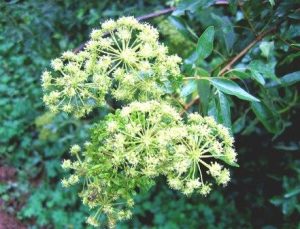
Heteromorpha arborescens. Photo: Stefaan Dondeyne. Source: Flora of Zimbabwe
The Parsley Tree Heteromorpha arborescens A small fragile tree found on hillsides, rocky wooded ravines and at the edges of forests, the flowers and seeds of which smell strongly of carrots and parsley. They form in dense round umbels at the tips of branches and are an excellent addition to potpourri. The tree is much prized in African medicine.
Tea made by boiling a cupful of leaves in water for ten minutes is prescribed for stomach upsets, colic, flatulence, and intestinal worms. Also used for nervousness, mental disturbances and given to children who have nightmares and are easily frightened. Smoke inhaled from burning wood clears headaches and sinus congestion. A brew of the bark and roots is given for shortness of breath, asthma, bronchitis, coughs and colds. The bark is also used to treat skin aliments, scaly scalp conditions and eczema – made into a shampoo. Crushed leaves are used to treat ringworm and Itch and rubbed on mosquito bites, soothes them.
Animals are treated as well with muti from this small tree. The seeds germinate readily so herbalists should be encouraged to grow their own trees.
ANDY MACNAUGHTAN CHAIRMAN


